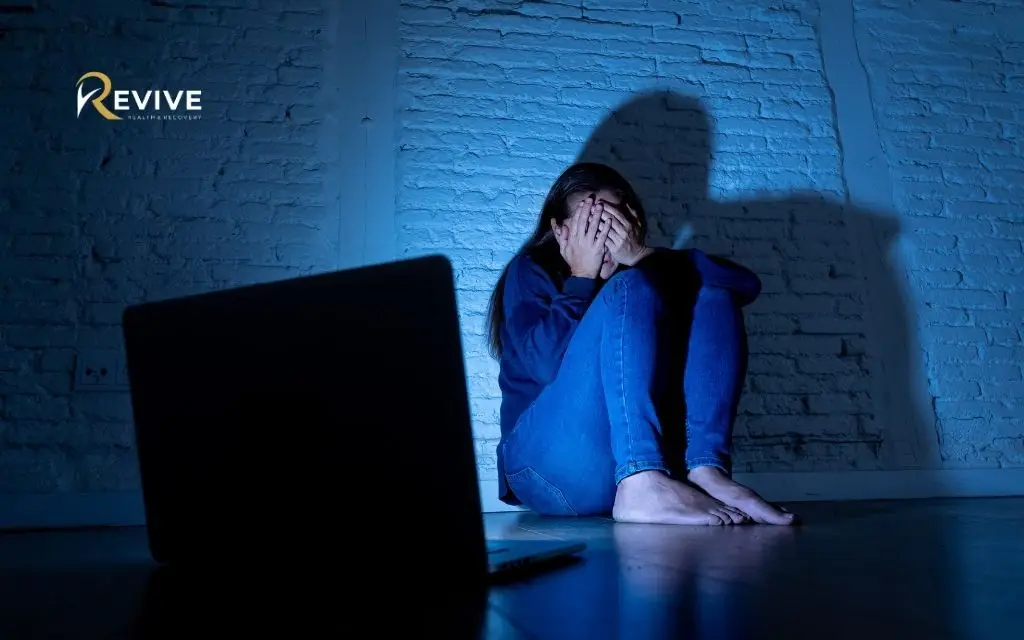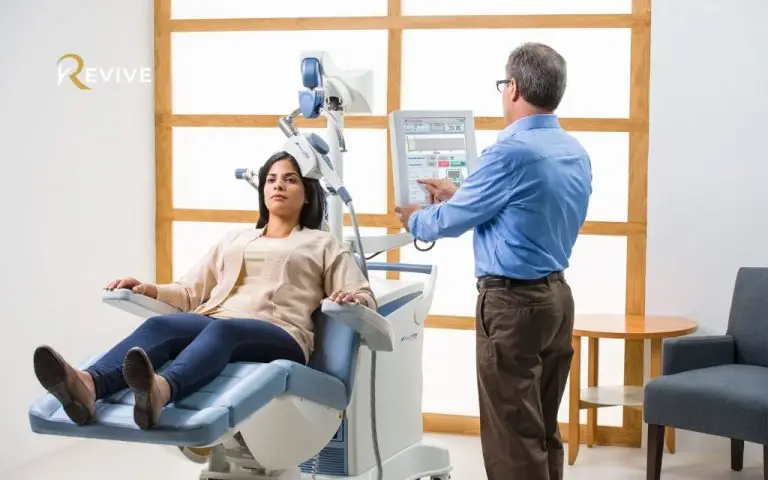You receive another notification. Your heart races before you even look. Another cruel message? Another humiliating post? This experience is more common than you think, and it leaves wounds deeper than many realize.
Cyberbullying and online trauma represent harassment through digital devices and platforms. Unlike traditional bullying that ends when you leave school, online harassment follows you everywhere. The messages come at any hour. Posts stay visible to thousands of people. The damage creates real psychological trauma deserving professional treatment.
Recent statistics reveal that 58% of Gen Z has experienced cyberbullying or online abuse. These digital experiences trigger the same trauma responses as physical assaults, leading to depression, anxiety, and PTSD.
This article will help you understand how cyberbullying creates trauma, recognize symptoms, and discover effective treatment options in Denver. Recovery is possible.
If you’re struggling with online harassment, Revive Health Recovery can help. Call us anytime at (303) 268-4655.
Understanding cyberbullying: more than “just online drama”
What is cyberbullying? Definition and types
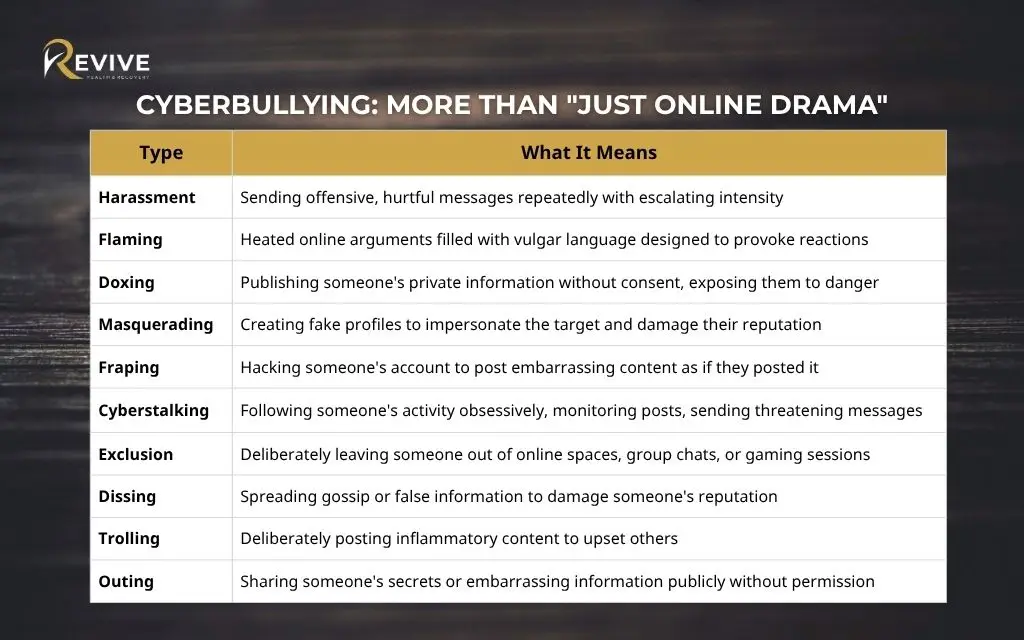
Cyberbullying involves willful, repeated harm delivered through electronic communications. This definition distinguishes it from a single mean comment or one-time conflict. The behavior must be intentional and persistent, creating a pattern of digital harassment that causes psychological distress.
The harm takes many forms across different platforms:
| Type | What It Means |
| Harassment | Sending offensive, hurtful messages repeatedly with escalating intensity |
| Flaming | Heated online arguments filled with vulgar language designed to provoke reactions |
| Doxing | Publishing someone’s private information without consent, exposing them to danger |
| Masquerading | Creating fake profiles to impersonate the target and damage their reputation |
| Fraping | Hacking someone’s account to post embarrassing content as if they posted it |
| Cyberstalking | Following someone’s activity obsessively, monitoring posts, sending threatening messages |
| Exclusion | Deliberately leaving someone out of online spaces, group chats, or gaming sessions |
| Dissing | Spreading gossip or false information to damage someone’s reputation |
| Trolling | Deliberately posting inflammatory content to upset others |
| Outing | Sharing someone’s secrets or embarrassing information publicly without permission |
Current research shows that one in five tweens experiences some form of online harassment. Among teenagers, 25% report cyberbullying victimization. These numbers have climbed steadily as young people spend more time online for school, socializing, and entertainment.
Understanding these different types matters because each creates unique psychological impacts. The trauma from having your private information exposed differs from the pain of systematic exclusion from peer groups. Both hurt, both can cause lasting damage, and both deserve professional intervention.
Why cyberbullying creates unique trauma
The nature of digital harassment creates psychological wounds that differ from traditional bullying in several critical ways:
24/7 Accessibility – No Safe Haven
- Traditional bullying ended when you left school
- Online harassment follows you everywhere
- Attacks come during dinner, late at night, early morning, and weekends
- No time or place feels safe from harassment
Permanent Digital Footprint
- Screenshots circulate indefinitely across platforms
- Content stays visible for years, even after deletion attempts
- You can’t escape past experiences
- Evidence of humiliation remains searchable by anyone
Wider Audience Amplifies Shame
- Traditional bullying involved a small peer group
- Online harassment reaches hundreds or thousands within hours
- Your painful moments become public entertainment
- The scale of exposure intensifies psychological impact
Anonymity Creates Additional Fear
- You don’t know who’s attacking you or why
- Faceless threats feel more menacing
- No body language or context to understand intent
- The uncertainty itself becomes traumatic
These unique characteristics explain why cyberbullying and online trauma require specialized treatment approaches. Standard interventions don’t address the specific ways digital harassment impacts your psychological wellbeing.
Cyberbullying statistics in 2025: the growing crisis
The data paints a concerning picture of how widespread online trauma has become:
| Statistic | Impact |
| 58% of Gen Z | Have experienced cyberbullying or online abuse |
| 93% of victims | Report hopelessness, sadness, or depression |
| 50% increased risk | Of suicidal thoughts among cyberbullying victims |
| 66% of victims | Say it negatively impacted their self-perception |
| 48% of teens | Say social media has mostly negative effects (up from 32% in 2022) |
| 33% of students | Report cyberbullying affected their ability to learn and feel safe |
These aren’t temporary mood changes. The emotional impact creates persistent mental health challenges that interfere with daily functioning. The psychological distress reaches clinical levels requiring professional intervention.
If these statistics describe your experience, you’re not alone. At Revive Health Recovery, we’ve helped many individuals recover from cyberbullying trauma through evidence-based outpatient treatment. Call (303) 268-4655 to learn how we can support your healing journey.
Online trauma: when digital experiences leave emotional scars
What is online trauma?
Online trauma describes psychological distress from negative digital experiences. This encompasses more than direct cyberbullying alone. The concept includes various harmful online interactions that activate trauma responses. These experiences create lasting psychological symptoms requiring professional treatment.
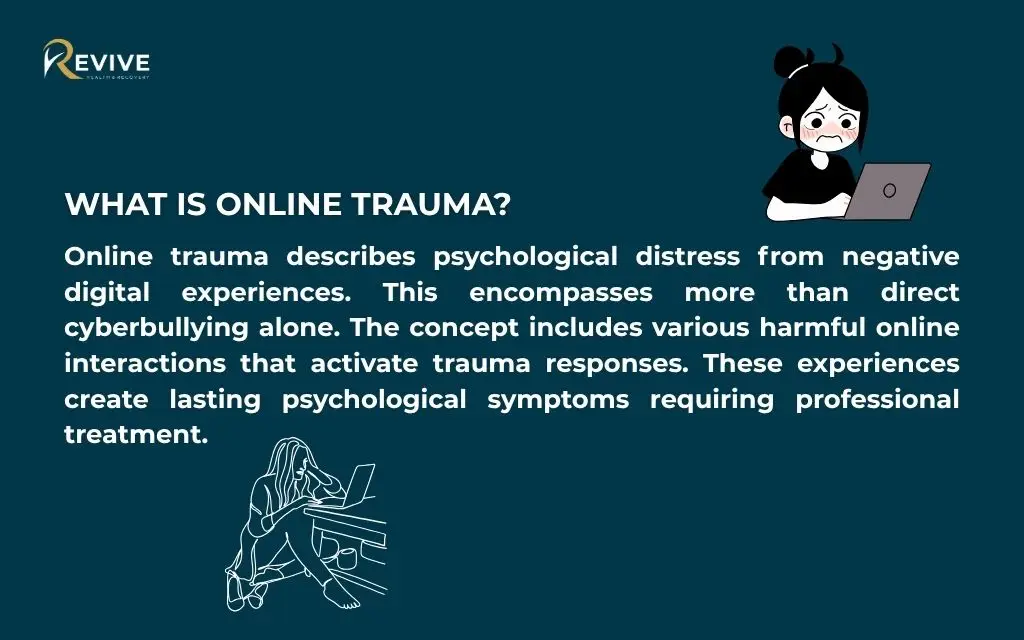
Direct cyberbullying involves targeted harassment through messages, posts, or attacks. Secondary trauma occurs when you witness disturbing graphic content online. Going viral for negative reasons creates intense humiliation and distress. Doxing and cyberstalking expose your information and create constant anxiety.
Your brain processes digital experiences as real threats to your safety. Notifications from harassers trigger your nervous system’s danger response immediately. The fight-flight-freeze response activates even though threats exist only digitally. Understanding that online trauma is real trauma validates your experiences.
How cyberbullying causes PTSD and trauma responses
Research confirms that chronic cyberbullying triggers the same PTSD symptoms as other traumatic events: flashbacks, hypervigilance, avoidance, and intrusive thoughts.
Why it happens: Your brain cannot distinguish between online and offline threats. The same neurological pathways activate whether harm comes through a screen or in person, creating legitimate trauma requiring professional treatment.
Common trauma responses:
- Anxiety with every phone notification
- Obsessively checking accounts
- Avoiding apps but can’t stop thinking about them
- Constant state of alert and fear
- Physical symptoms even when no threat exists
Social exclusion hurts: Being deliberately left out of group chats or online communities activates the same brain regions involved in physical pain processing. Your social pain is real pain.
If you recognize these responses, professional help makes a significant difference. Revive Health Recovery offers specialized trauma therapy for PTSD. Contact us at contact@revivehealthrecovery.com or call (303) 268-4655.
The long-term impact: trauma can surface years later
Cyberbullying trauma often has delayed effects that appear years later. You might believe you’ve moved on from past harassment. However, unprocessed trauma still affects your life in hidden ways. Symptoms can emerge months or even years after the original incidents.
New stressors or life transitions often trigger dormant trauma responses. Starting a new job or relationship can activate old wounds. Suddenly you experience anxiety, depression, or flashbacks from years-ago harassment. Identity formation during critical periods creates lasting impacts on relationships and careers.
Physical health consequences also emerge over time from unprocessed trauma. Chronic stress contributes to headaches, insomnia, digestive problems, and fatigue. The good news: treatment remains effective regardless of timing. EMDR therapy can help you process decades-old experiences successfully.
Recognizing the signs: symptoms of cyberbullying trauma
Emotional and psychological symptoms
The emotional impact of cyberbullying and online trauma manifests in various psychological symptoms that interfere with your daily wellbeing. Depression and persistent sadness affect 93% of cyberbullying victims according to current research. This isn’t ordinary sadness that passes after a bad day. The depression feels heavy, inescapable, and unrelenting.
Anxiety and panic attacks become common responses to online harassment. You might experience racing thoughts, difficulty breathing, chest tightness, or overwhelming fear. Low self-esteem and negative self-perception develop as you internalize the cruel messages directed at you. You begin believing the lies. Your confidence erodes.
Feelings of hopelessness and helplessness create a sense that things will never improve. Shame and embarrassment keep you isolated. You feel humiliated by what happened to you. Anger and irritability appear as your nervous system stays activated. Fear and hypervigilance dominate your mental state. You constantly scan for threats.
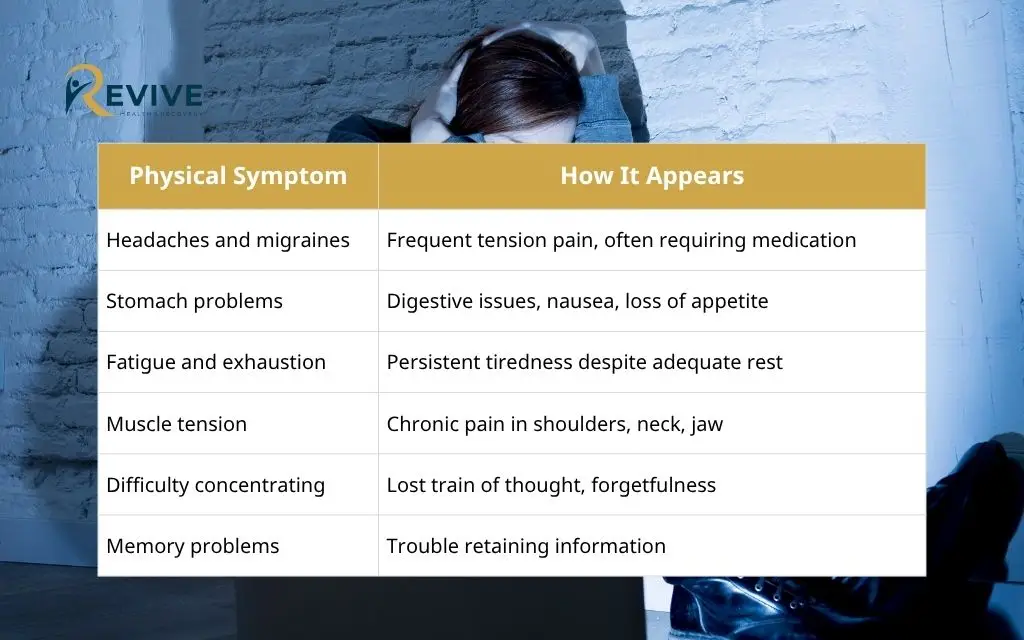
Behavioral changes to watch for
Observable behavioral changes often signal that someone is experiencing cyberbullying trauma. Social withdrawal and isolation represent common coping mechanisms. You might stop attending social events, avoid friends, or spend increasing amounts of time alone.
Your relationship with social media and devices becomes complicated. Some people develop avoidance behaviors, refusing to check certain platforms. Others engage in excessive monitoring, compulsively checking accounts. Changes in sleep patterns signal psychological distress. Insomnia makes it difficult to fall asleep as your mind replays harassment.
Academic or work performance typically declines when you’re dealing with trauma. Concentration becomes difficult. Your memory fails you. Some people turn to substance use as a coping mechanism for their emotional pain. Self-harm behaviors may emerge as you struggle to manage overwhelming emotions.
The most concerning behavioral change involves suicidal thoughts or attempts. Remember that cyberbullying victims face a 50% increased risk of suicidal ideation. If you’re experiencing thoughts of ending your life, this represents a medical emergency requiring immediate help.
Physical symptoms of digital trauma
Trauma doesn’t exist only in your mind. Your body carries the stress and manifests it through various physical symptoms:
| Physical Symptom | How It Appears |
| Headaches and migraines | Frequent tension pain, often requiring medication |
| Stomach problems | Digestive issues, nausea, loss of appetite |
| Fatigue and exhaustion | Persistent tiredness despite adequate rest |
| Muscle tension | Chronic pain in shoulders, neck, jaw |
| Difficulty concentrating | Lost train of thought, forgetfulness |
| Memory problems | Trouble retaining information |
These physical symptoms often prompt medical visits where healthcare providers find no clear physical cause. Understanding that trauma creates real physical symptoms helps you seek appropriate mental health treatment rather than endless medical testing.
Signs in teens vs. adults
The presentation of cyberbullying trauma differs somewhat between age groups:
| Teens | Adults |
| School avoidance, making excuses to stay home | Work difficulties, trouble concentrating in meetings |
| Device anxiety when separated from phones | Relationship trust issues in partnerships |
| Sudden changes in friend groups | Generalized anxiety beyond online interactions |
| Intense mood swings beyond normal fluctuations | Unresolved childhood trauma resurfacing |
| Peer relationship changes | Difficulty with vulnerability and authenticity |
Recognizing these symptoms in yourself or a loved one represents the first step toward healing. You don’t have to live with these symptoms forever. Professional treatment for cyberbullying trauma therapy Denver can help you recover.
Revive Health Recovery: (303) 268-4655 | 1427 S Federal Blvd, Denver, CO 80219
The path to healing: treatment options for cyberbullying trauma
Why professional treatment is essential
You might wonder whether you can heal from cyberbullying and online trauma on your own. While self-help strategies offer some support, professional treatment proves essential for several important reasons.
Evidence-based therapeutic approaches demonstrate 70-90% success rates for trauma treatment. These statistics represent real people who recovered their wellbeing and rebuilt their lives. Early intervention prevents long-term complications from developing. When you address trauma symptoms promptly, you reduce the risk of chronic PTSD, persistent depression, or anxiety disorders.
Professional validation reduces shame and stigma that keep many people suffering in silence. Working with a therapist who specializes in trauma helps you understand that your symptoms are normal responses to abnormal situations. A structured therapeutic approach ensures complete healing rather than partial symptom relief.
Evidence-based therapies for online trauma
Several therapeutic approaches demonstrate strong effectiveness for treating cyberbullying trauma.
EMDR (Eye movement desensitization and reprocessing)
EMDR represents a specialized therapy designed specifically for trauma memory reprocessing. The approach helps your brain digest distressing experiences that got stuck in your nervous system. During EMDR sessions, you recall traumatic memories while engaging in bilateral stimulation, typically through guided eye movements.
This process helps your brain reprocess the memories in adaptive ways. The emotional charge attached to the memories decreases. You develop new insights and perspectives about your experiences. The memories themselves don’t disappear, but they no longer trigger intense distress.
Research confirms EMDR’s effectiveness for cyberbullying trauma specifically. Virtual EMDR has proven effective in reducing PTSD symptoms, making treatment accessible even if you prefer online therapy sessions. Treatment timeline varies by individual, but many people experience significant improvement within a few weeks to four months.
Trauma-focused cognitive behavioral therapy (TF-CBT)
TF-CBT helps you identify and reframe negative thought patterns that developed from cyberbullying experiences. The therapy recognizes that trauma creates distorted beliefs about yourself, others, and the world. Through TF-CBT, you learn to recognize thoughts like “I’m worthless” or “Everyone hates me” as trauma responses rather than facts.
Building coping strategies represents another core component. You learn specific skills for managing anxiety, processing difficult emotions, and responding to triggers. Addressing shame and self-blame proves crucial for recovery. Many cyberbullying victims blame themselves for the harassment they experienced. TF-CBT helps you understand that you didn’t cause or deserve the abuse.
Research evidence supports TF-CBT’s effectiveness across diverse populations and trauma types, including online trauma treatment Colorado.
Other effective approaches
Brainspotting works by identifying where you hold trauma in your brain and body. Somatic therapy addresses body-held trauma through awareness of physical sensations and movement. Group therapy for shared experiences provides unique healing benefits. Connecting with others who understand cyberbullying trauma reduces isolation. Mindfulness and meditation practices teach you to stay present rather than ruminating on past harassment. Medication when appropriate can support your recovery by managing symptoms like severe depression or anxiety.
Outpatient vs. inpatient treatment: what you need to know
Understanding the difference between outpatient and inpatient treatment helps you choose the appropriate level of care for your situation. Outpatient treatment offers several benefits that make it the preferred option for most people dealing with cyberbullying trauma.
The flexibility of outpatient care allows you to attend therapy sessions while maintaining your daily life. You continue working, going to school, and fulfilling family responsibilities. Cost effectiveness represents another advantage. Without hospitalization expenses, the overall investment remains more affordable.
Intensive Outpatient Programs (IOP) serve as a middle ground when you need more support than weekly therapy but don’t require hospitalization. Most cyberbullying trauma cases respond well to outpatient treatment. However, higher levels of care become necessary when active suicidal ideation exists.
Revive Health Recovery operates as an outpatient-only treatment center, focusing exclusively on providing flexible, effective care that doesn’t require hospitalization. Our approach recognizes that most people benefit from treatment that integrates into their existing lives.
Coping strategies: immediate steps to take
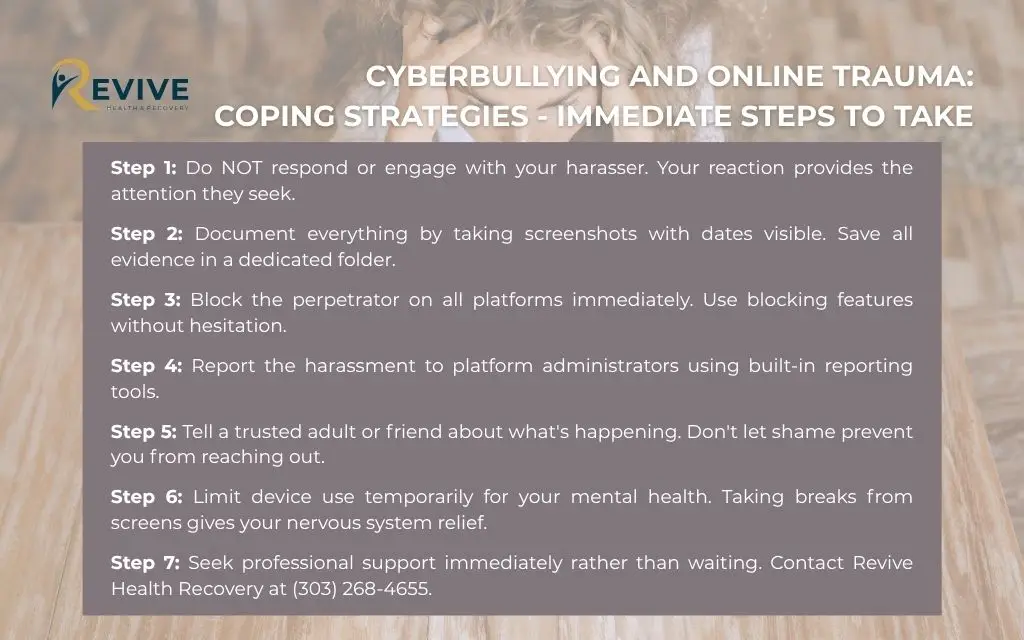
If you’re currently being cyberbullied
Taking action when experiencing active harassment can reduce the immediate harm and begin your path toward safety:
- Step 1: Do NOT respond or engage with your harasser. Your reaction provides the attention they seek.
- Step 2: Document everything by taking screenshots with dates visible. Save all evidence in a dedicated folder.
- Step 3: Block the perpetrator on all platforms immediately. Use blocking features without hesitation.
- Step 4: Report the harassment to platform administrators using built-in reporting tools.
- Step 5: Tell a trusted adult or friend about what’s happening. Don’t let shame prevent you from reaching out.
- Step 6: Limit device use temporarily for your mental health. Taking breaks from screens gives your nervous system relief.
- Step 7: Seek professional support immediately rather than waiting. Contact Revive Health Recovery at (303) 268-4655.
Helping someone experiencing cyberbullying trauma
If someone you care about is suffering from online harassment, your support can make a significant difference in their recovery. The most important thing you can do is listen without judgment. Be present with them. Don’t minimize their pain or rush to fix the situation.
Validate their feelings and experiences by acknowledging that what happened to them was real and hurtful. Ask how you can help specifically rather than assuming you know what they need. Encourage professional treatment by offering to help them find a therapist or accompany them to an initial appointment.
Don’t minimize their experience by saying things like “just ignore it” or “it’s not that bad.” These statements, though well-intentioned, invalidate their pain and can increase feelings of isolation. Continue checking in regularly even after the acute crisis passes.
Building resilience during recovery
As you work through trauma treatment, certain practices strengthen your resilience and support long-term wellbeing. Establish healthy device boundaries by setting specific times when you check social media. Practice self-compassion by treating yourself with the same kindness you’d offer a good friend.
Connect with a supportive community of people who understand your experiences. Engage in physical activity for stress relief and nervous system regulation. Journal about your experiences and feelings to process emotions and track your progress. Celebrate small victories in your recovery process.
Recovery from cyberbullying and online trauma takes time, patience, and support. Be gentle with yourself throughout this process.
Finding help in Denver: cyberbullying trauma treatment resources
Why choose outpatient treatment in Denver
Denver offers excellent mental health treatment with qualified providers who stay current on digital-age challenges like online trauma. The metro area provides convenient locations, flexible scheduling, and both in-person and virtual therapy options.
Benefits of local care include therapists who understand your community context and life circumstances. Many Denver providers accept major insurance plans, making quality care accessible. Revive Health Recovery works with various insurance providers. Contact us to discuss your specific coverage and options.
What to look for in a trauma therapist
Finding the right therapist significantly impacts your outcomes. Look for:
- Specialized training in EMDR or TF-CBT
- Experience with cyberbullying and digital trauma
- Compassionate, non-judgmental approach
- Evidence-based treatment methods
- Flexible scheduling and online options
- Understanding of teen and young adult issues (if applicable)
These qualifications ensure your therapist understands the unique psychological patterns created by online harassment and can provide effective, research-backed treatment.
Why choose Revive Health Recovery for cyberbullying trauma
At Revive Health Recovery, we specialize in treating trauma from cyberbullying and online harassment. Our team uses evidence-based EMDR and CBT approaches proven effective for PTSD treatment. We’ve created a compassionate, judgment-free environment where you can heal.
Our outpatient care model offers:
- No inpatient requirement
- Flexible online and in-person therapy options
- Personalized treatment plans tailored to your needs
- Evidence-based trauma processing techniques
- Skills building for long-term resilience
- Progress monitoring and adjusted approaches
- Convenient Denver location with 24/7 availability
Taking the first step: how to get started
Call: (303) 268-4655 (Available 24/7)
Email: contact@revivehealthrecovery.com
Visit: 1427 S Federal Blvd, Denver, CO 80219
We accept insurance and offer affordable options. Free initial consultations help you determine if we’re the right fit for your healing journey.
FAQs about cyberbullying and online trauma
Can cyberbullying really cause PTSD?
Yes. Research confirms that chronic online harassment triggers the same PTSD symptoms as other traumatic events, including flashbacks, hypervigilance, avoidance, and intrusive thoughts. Studies show a 50% increased risk of suicidal thoughts among victims. Your brain processes digital threats the same way it processes physical dangers, creating legitimate trauma responses requiring professional treatment. Revive Health Recovery specializes in treating PTSD from cyberbullying using evidence-based approaches like EMDR therapy. Call (303) 268-4655 to learn more about our trauma treatment services in Denver.
How long does it take to recover from cyberbullying trauma?
Recovery timelines vary by individual. Evidence-based treatments like EMDR and trauma-focused CBT typically show significant improvement within a few weeks to four months. However, recovery from bullying trauma is a lifelong process. Professional therapy provides tools for ongoing resilience rather than a one-time cure. The trauma may have lasting effects, but treatment helps you process experiences, reduce symptoms, and build coping skills that serve you throughout life. Starting treatment early improves your prognosis for complete recovery.
Is online trauma different from “real” trauma?
Online trauma is real trauma. Your brain doesn’t distinguish between digital and physical threats when processing traumatic experiences. The 24/7 nature of cyberbullying, the permanence of digital content, and the wider audience for humiliation can actually create more persistent trauma responses than some face-to-face experiences. The constant accessibility means you never feel safe. Professional treatment addresses online trauma with the same seriousness as any other traumatic experience.
What are the warning signs someone is experiencing online trauma?
Key signs include social withdrawal, anxiety around devices and notifications, depression, sleep disturbances, declining performance at school or work, low self-esteem, physical symptoms like headaches and stomach issues, avoidance of social media, and in severe cases self-harm or suicidal thoughts. Personality changes, increased irritability, or mood swings also signal potential trauma. If you notice these signs in yourself or someone you care about, Revive Health Recovery offers comprehensive assessment and treatment for cyberbullying trauma in Denver.
Can adults still be affected by childhood cyberbullying?
Yes. Trauma from adolescent online harassment can resurface years later when triggered by new stressors like job changes or relationship conflicts. Many adults struggle with trust issues, difficulty with vulnerability, generalized anxiety, and depression that trace back to cyberbullying during formative years. The good news is that EMDR therapy and other trauma-focused approaches remain effective regardless of how long ago the bullying occurred. Your brain retains its capacity to heal even from decades-old experiences. Contact Revive Health Recovery to discuss treatment options.
Conclusion: from trauma to transformation
Cyberbullying and online trauma represent serious mental health concerns affecting millions across all age groups. The symptoms include depression, anxiety, PTSD, physical health problems, and suicidal ideation. These effects may appear immediately or surface years later.
Recovery from cyberbullying and online trauma is not only possible, it’s probable with the right support. Your trauma doesn’t define you. Your pain is valid, and your recovery is achievable. You deserve to feel safe, valued, and at peace.
If you or someone you love is struggling with cyberbullying trauma, Revive Health Recovery is here to help. Our compassionate team specializes in trauma-focused therapy using proven methods like EMDR and CBT. We offer flexible outpatient treatment that fits your life.
Call us anytime, 24/7: (303) 268-4655
Email: contact@revivehealthrecovery.com
Visit: 1427 S Federal Blvd, Denver, CO 80219
Your journey toward healing starts with one phone call. Reach out today.
